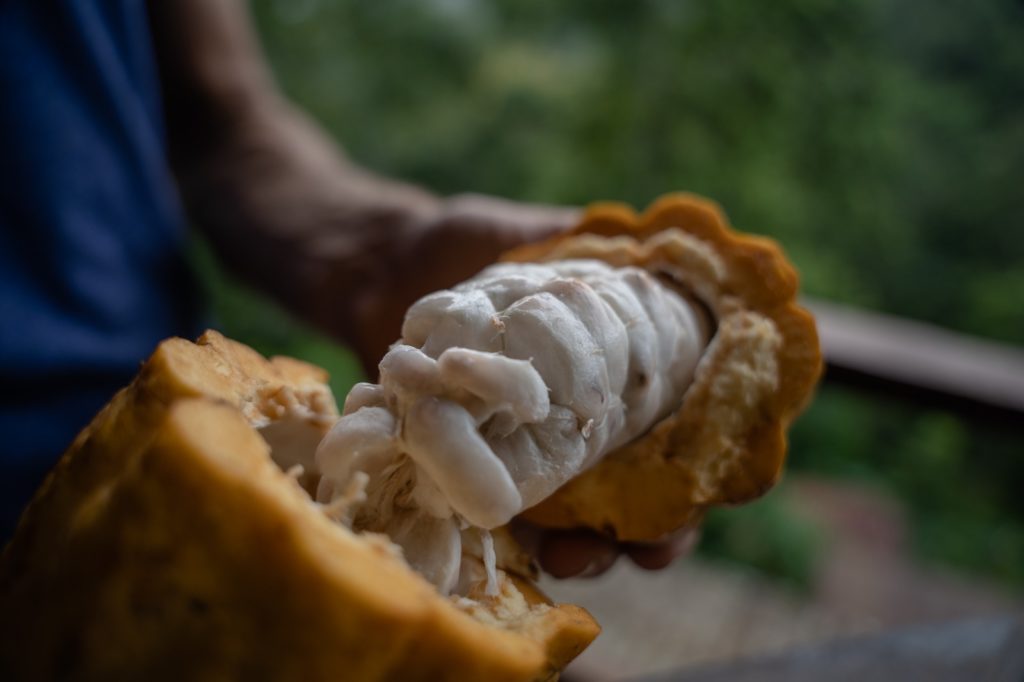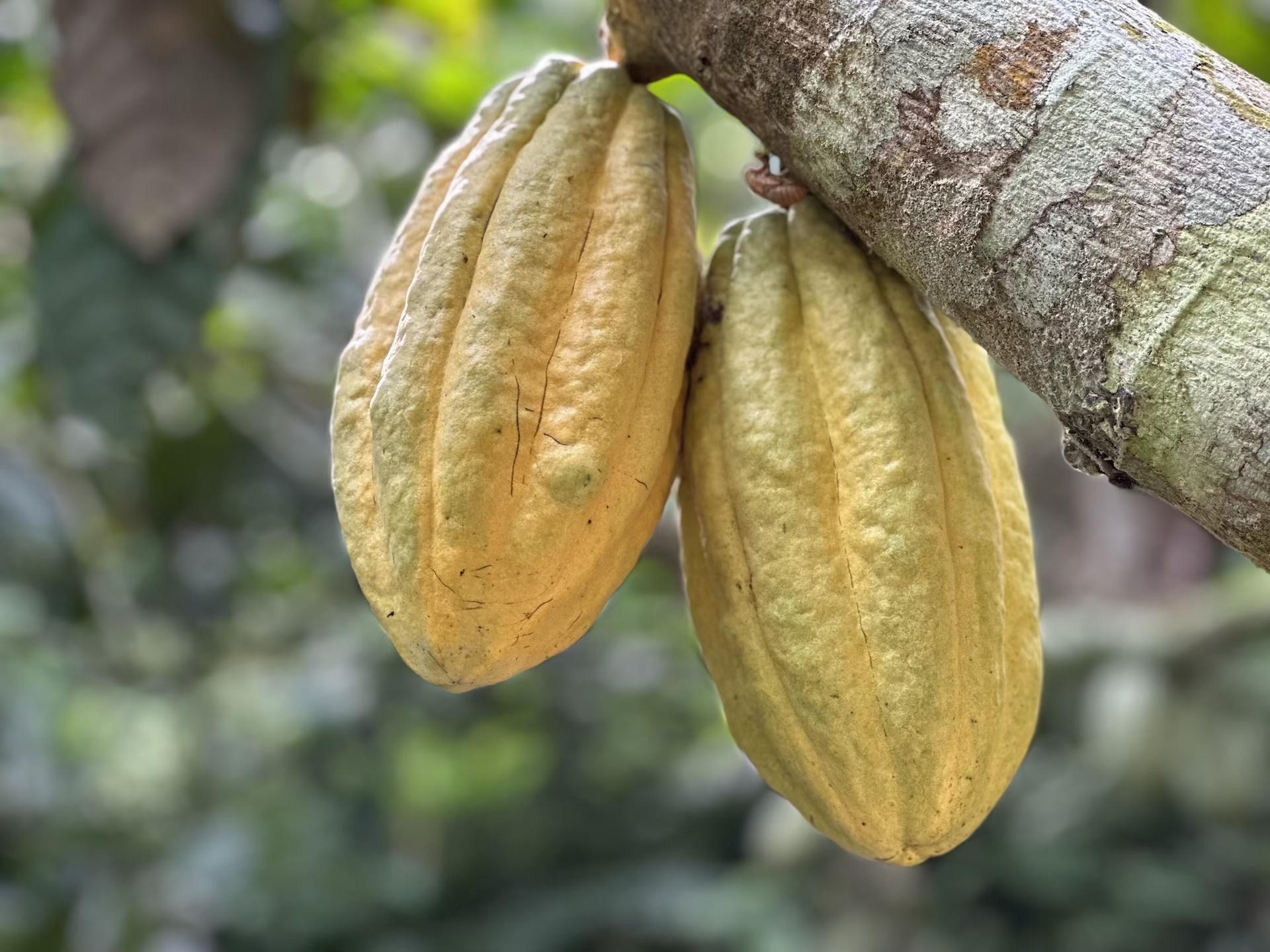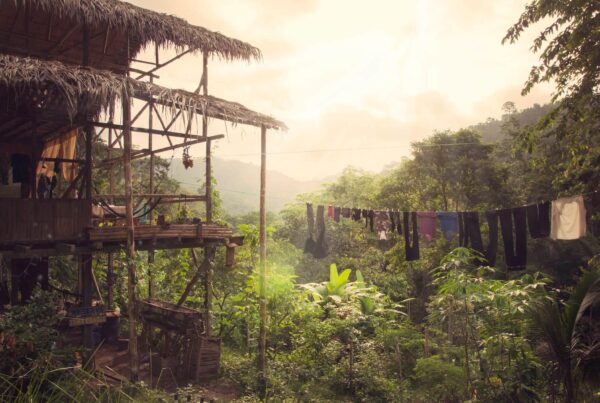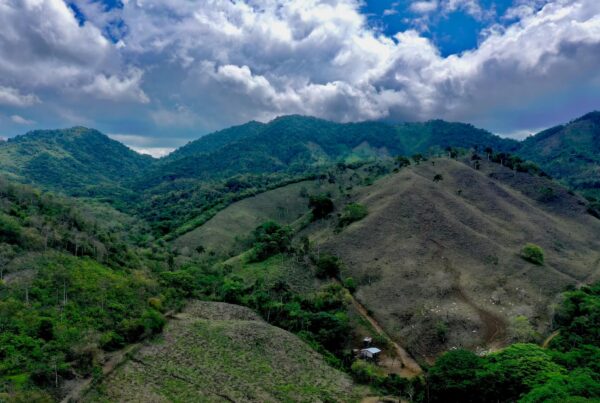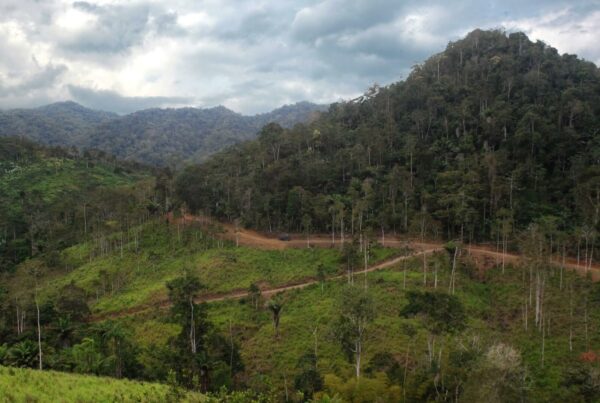Quick Summary
We’re using heirloom cacao trees to reverse deforestation and help restore a threatened rainforest in Ecuador. It’s a real-life example of how businesses, conservationists, and local farmers can join forces to help regenerate the forest rather than cut it down—as featured in Smithsonian Magazine and Mongabay.
Where: The Capuchin Corridor, which protects one of the last remnants of the Pacific Forest of Ecuador—the most endangered rainforest on earth.
What: A comprehensive regenerative agroforestry program. Local farmers combine cacao trees with a diversity of native shade trees, fruit trees, and other food-producing crops—all of which are planted on degraded land. The result is forest restoration + local food security + farmer income + CO2 removal from the atmosphere.
Partners:
- TMA is a non-profit rainforest conservation organization working to protect and restore the Pacific Forest of Ecuador since 2007.
- To’ak is a luxury chocolate company based in Ecuador, known for making its chocolate like a vintage wine, aging it like a whisky, packaging it like a work of art, and sourcing from the rarest and most prized cacao variety on earth.
Who else wants to join? We’re opening this opportunity up to other chocolate companies who want to be part of this project and source their cacao from this origin. For those interested, please fill out this form.
Why?
- Farmers earn a living and rehabilitate the ecosystem at the same time.
- Craft chocolate makers gain access to one of the most coveted cacao varieties on earth, and have an extraordinary story to tell.
- Chocolate consumers can feel good about the brands they support and the chocolate they eat.
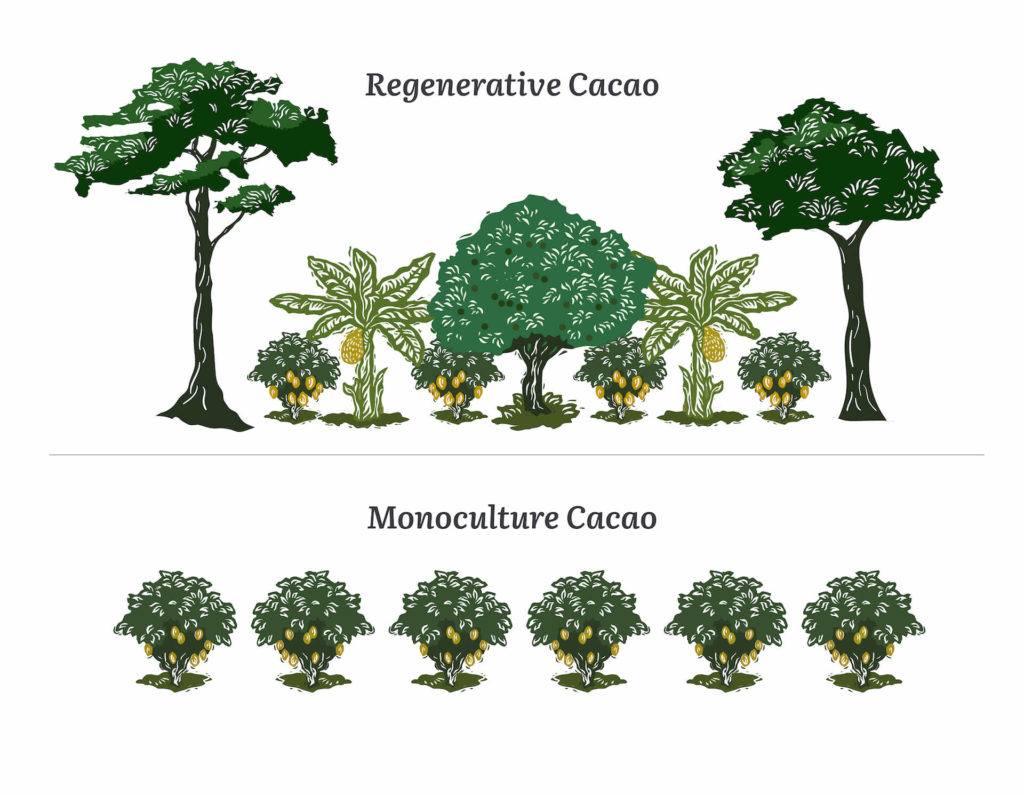 How it Works
How it Works
Here’s how TMA’s Regenerative Cacao program works:
- Farmers plant a diverse mix of native shade trees, fruit trees, and heirloom cacao trees on degraded land.
- TMA provides all the materials and covers the start-up costs. This includes direct cash payments to farmers during the crucial transition period until their tree crops start producing income.
- Native shade trees remove CO2 from the atmosphere and boost biodiversity, while fruit trees and bananas provide local food security, and cacao trees provide a sustainable source of income for families.
- Chocolate makers like To’ak play a key role by paying farmers at least 3x more than the standard market price for the cacao, which includes DNA-verified Ancient Nacional cacao.
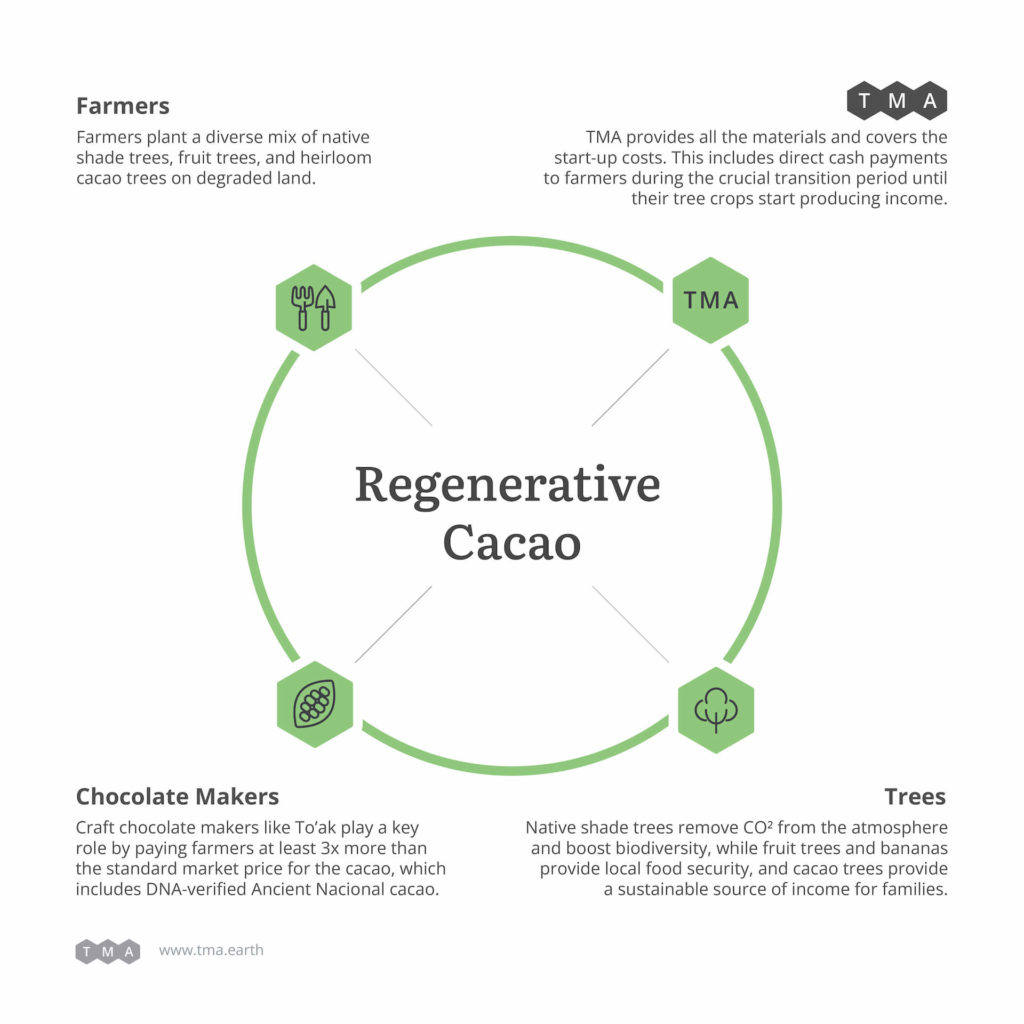 Backstory
Backstory
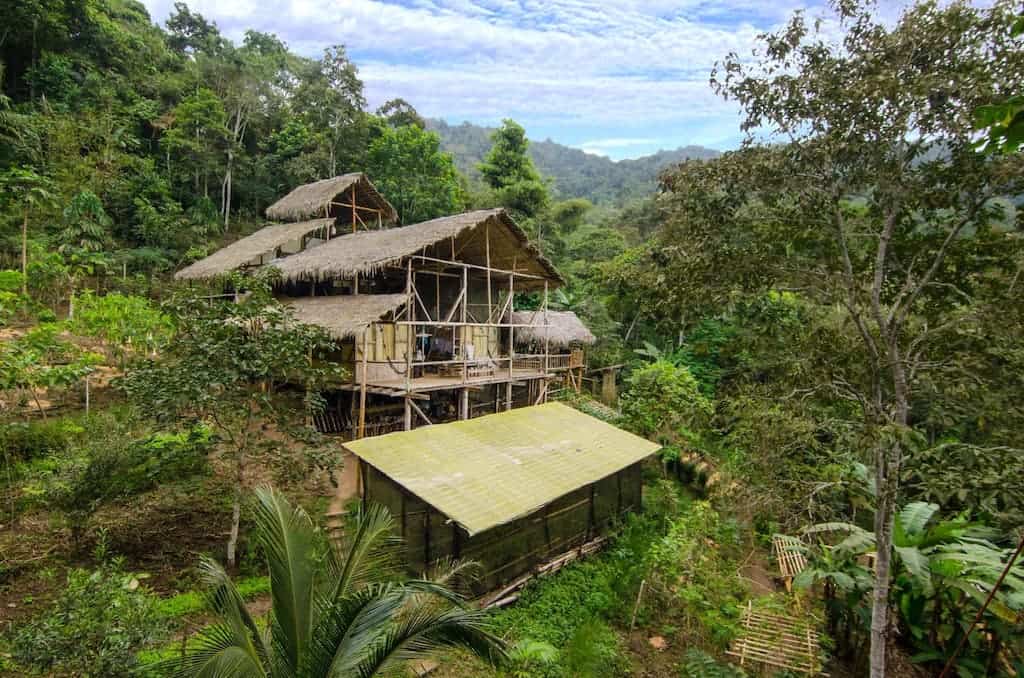
TMA created a forest preserve in 2007 called the Jama-Coaque Reserve (pronounced Hama Ko-Ah-Kay). It protects one of the last remnants of the Pacific Forest of Ecuador. To expand the size of the forest, TMA started working with local farmers in nearby properties to convert degraded land into regenerative cacao farms. In the course of this work, one of TMA’s co-founders, Jerry Toth, became obsessed with cacao farming and chocolate making, and eventually co-founded a chocolate company called To’ak in 2013.
To’ak went on to become the global pioneer of luxury dark chocolate—featured in Forbes, Fortune Magazine, Robb Report, The Guardian, Wine Spectator, Vice Magazine, TV channels such as CNBC, FOX, ARD, and over a hundred other media outlets across six continents. One of the reasons for To’ak’s success was unique access to old-growth cacao groves in the valley of Piedra de Plata. With the help of the Heirloom Cacao Preservation Fund and the USDA genetic lab, DNA analysis performed on some of the trees in this valley revealed them to be 100% pure Ancient Nacional cacao—a legendary cacao variety once believed to be extinct. These are the mother trees of many of the cacao trees that are now growing in the Capuchin Corridor.
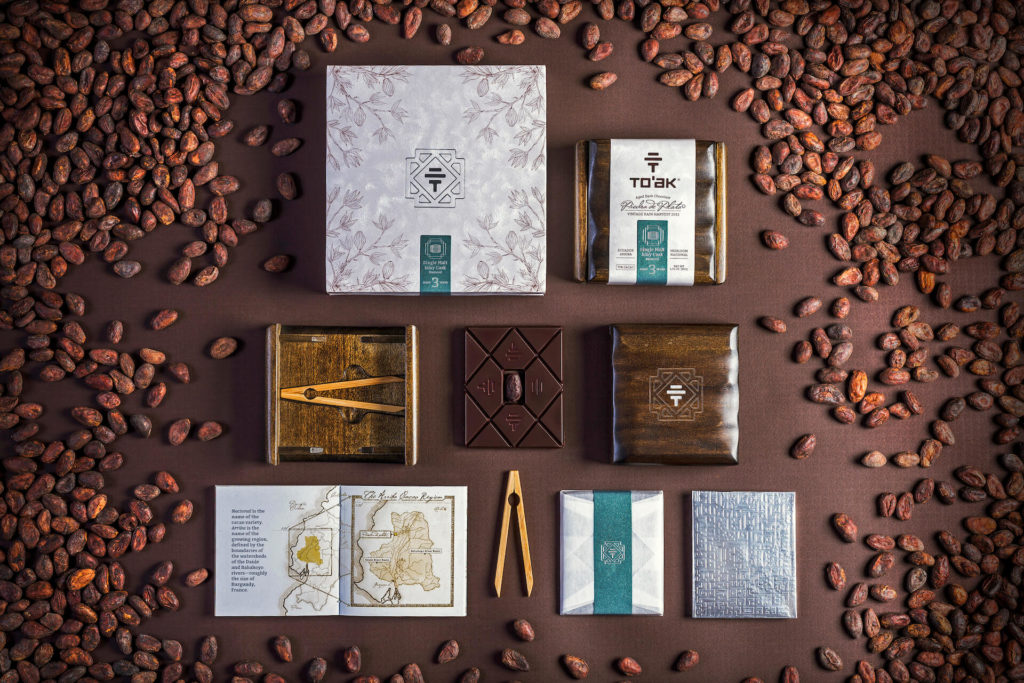
Limited edition To’ak chocolate bar aged in a Laphroaig whisky cask for 3 years: retail value $215 USD. Photo by To’ak.
The Capuchin Corridor is a large-scale conservation initiative to connect the Jama-Coaque Reserve to another threatened forest preserve in this region. This will create a contiguous forest that spans a 43-km mountain range that rises up from the shores of the Pacific ocean in coastal Ecuador.
To’ak and TMA worked together to preserve this genetic line of cacao by grafting the old-growth trees of Piedra de Plata onto young seedlings planted in a protected parcel of land inside TMA’s forest preserve. This so-called “Noah’s Ark of Ancient Nacional” now contains 189 cacao trees cloned from nine mother trees that are DNA-verified to be 100% pure Ancient Nacional.
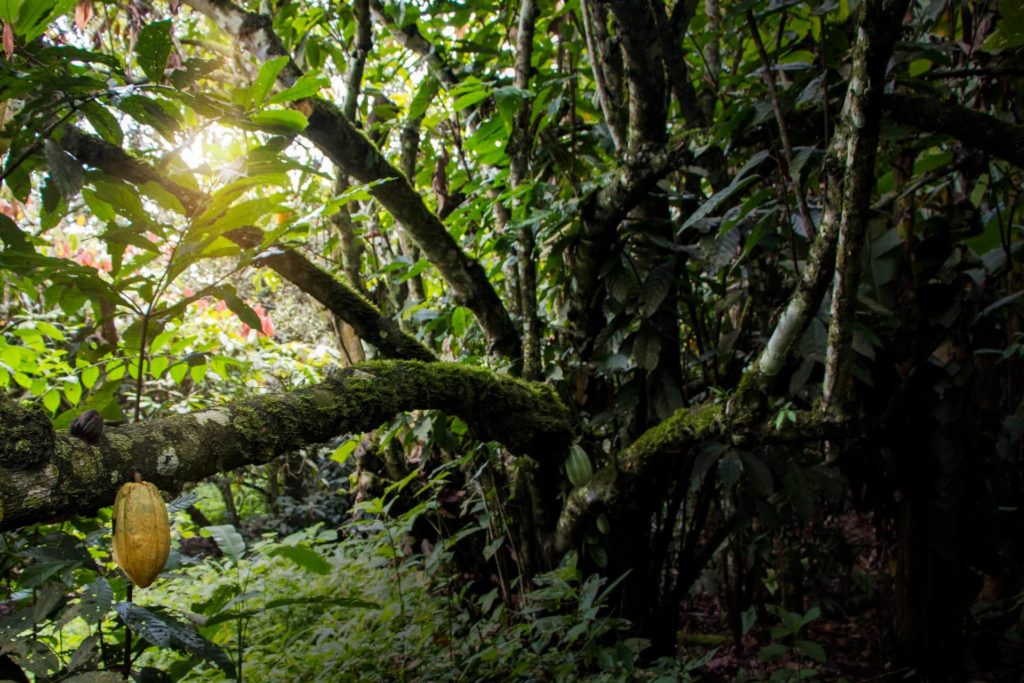
DNA-verified Ancient Nacional tree in Piedra de Plata – over 100 years old. Photo by To’ak.
TMA uses these trees as budwood to graft onto thousands of young cacao seedlings every year—effectively cloning the DNA-verified Ancient Nacional trees from Piedra de Plata. TMA then distributes these seedlings to farmers in the Regenerative Cacao program that are working to restore forest in the Capuchin Corridor.
In the Capuchin Corridor, the famously-aromatic (but relatively low-yielding) Ancient Nacional cacao trees are interplanted with heirloom Nacional varieties that have been growing in these mountains for over half a century, in addition to Nacional hybrids developed by INIAP that offer farmers relatively higher yields. More details on the genetics of Capuchin Cacao are provided below.
The Capuchin Corridor is named in honor of the Ecuadorian Capuchin Monkey, which is listed as critically endangered on the IUCN red list and depends on this forest for its survival.
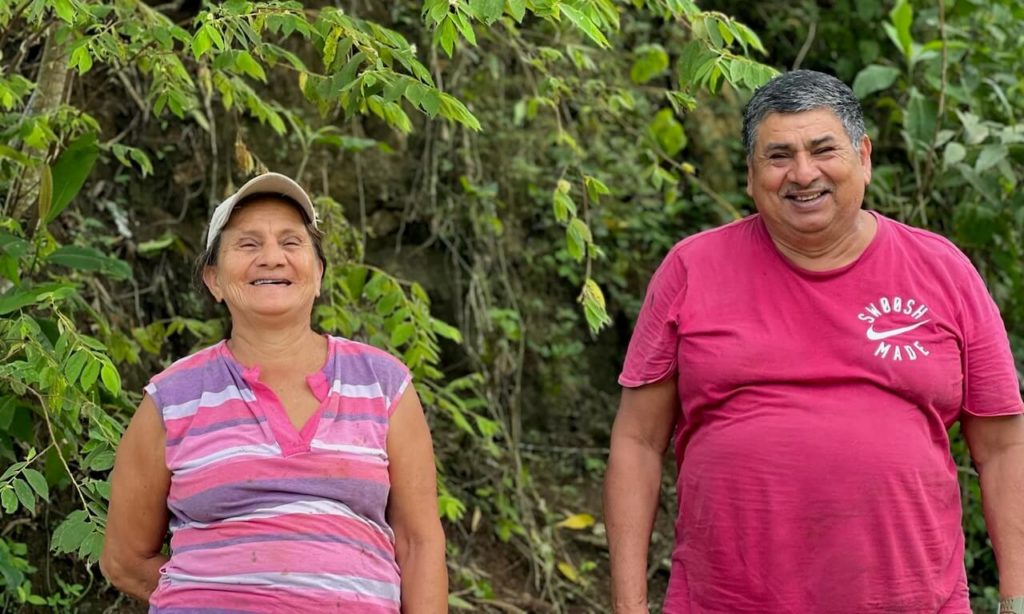
Two of the first farmers to enroll in the TMA’s Regenerative Cacao program: Alinda Murillo and her brother Wulvio Murillo. Photo by Liz Kimbrough.
Cacao Farms that Mimic the Tropical Forest
TMA works with two categories of farmers:
- Farmers who are converting degraded land into regenerative agroforestry farms.
- Farmers who are rehabilitating old cacao farms into regenerative agroforestry farms.
In both cases, farmers intercrop cacao trees with other kinds of trees and food-producing crops like bananas. In other words, they cultivate a food forest that mimics the structure of a natural forest. That’s the basis of agroforestry.
TMA provides farmers with all the materials and covers the start-up costs for converting to regenerative agroforestry. This includes direct cash payments to farmers during the crucial transition period until their tree crops start producing income. These bridge payments range from $3,000-4,500 per hectare over a 5-year period.
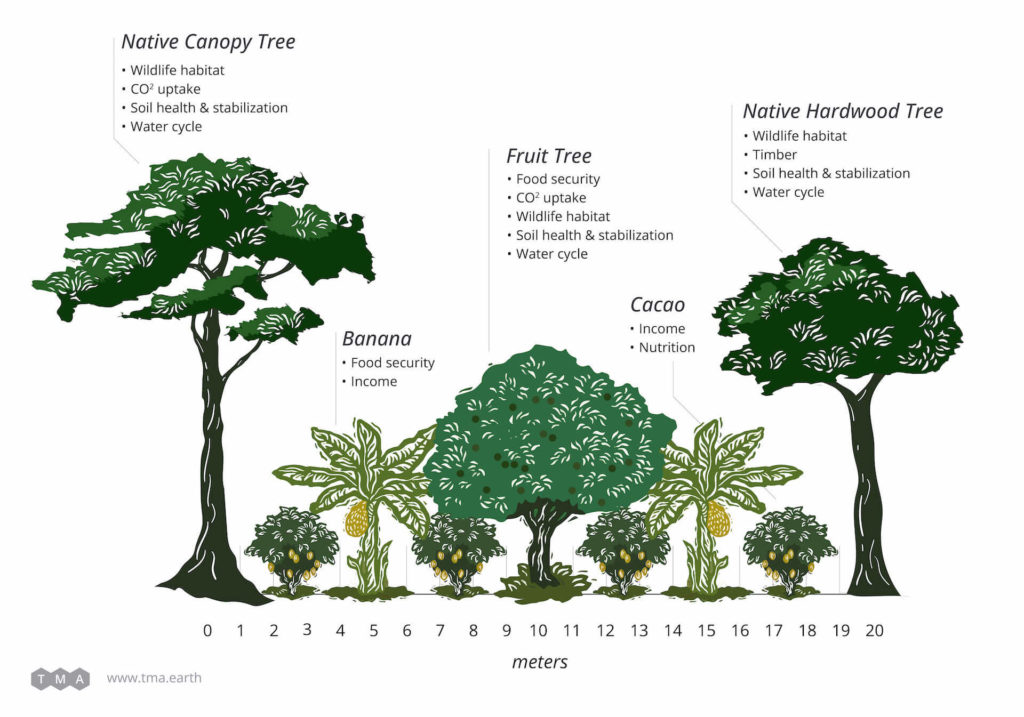
Planting Design & Biodiversity Metrics
On average, TMA’s Regenerative Cacao have over 30 different species of food-producing and native canopy trees. To satisfy biodiversity requirements, each farm needs to have at least:
- 100 shade trees per hectare
- 15 tree species per hectare
- of which at least 30% are native species
- Shannon Diversity index of 2.0 or greater
- Non-organic pesticides, herbicides, and fertilizers cannot be used
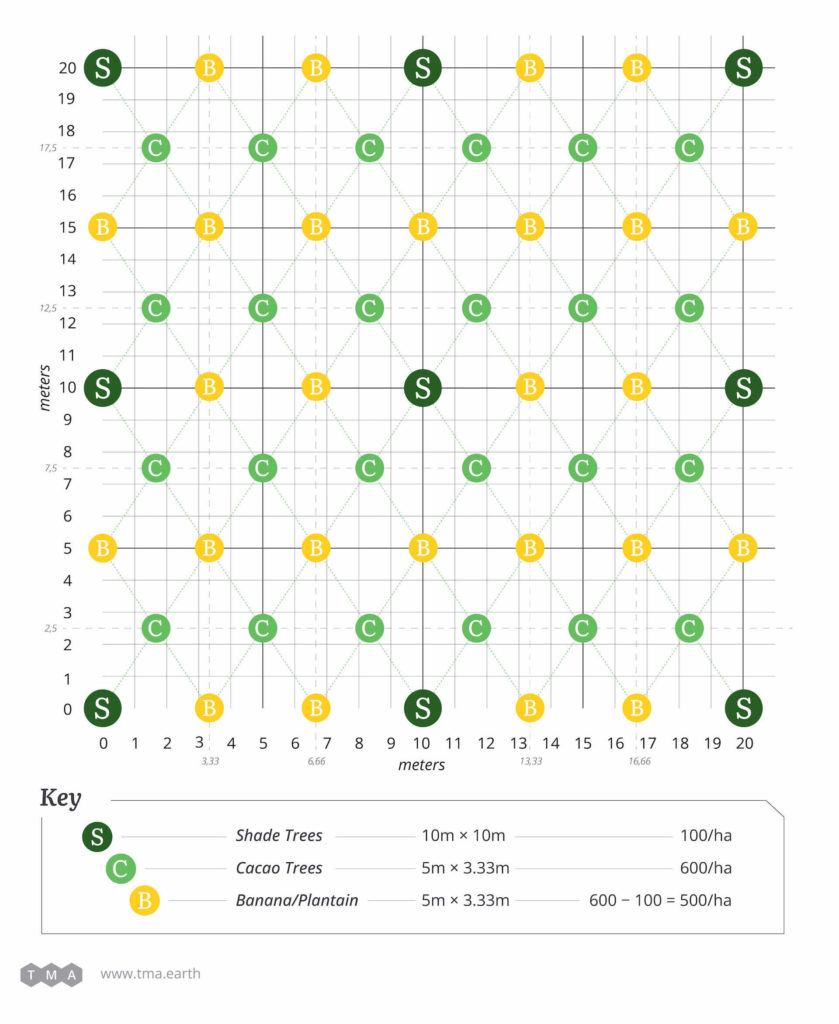
Monitoring
TMA’s field coordinators visit every single farm twice a year to audit the farm’s management in accordance with organic principles and best practices for regenerative agroforestry.
These same coordinators also perform a tree census—they manually count every single tree in the cacao parcel, identify which species it is, and classify it according to height.
The data from the tree census is fed into a database that analyzes the biodiversity value of each farm. Aerial imagery is used to corroborate the results.
Farms with high biodiversity scores receive the highest prices. Farms with moderate biodiversity scores are paid lower prices and are given one year to make necessary adjustments. Farms that do not satisfy TMA’s biodiversity requirements are ineligible to sell their cacao to TMA.
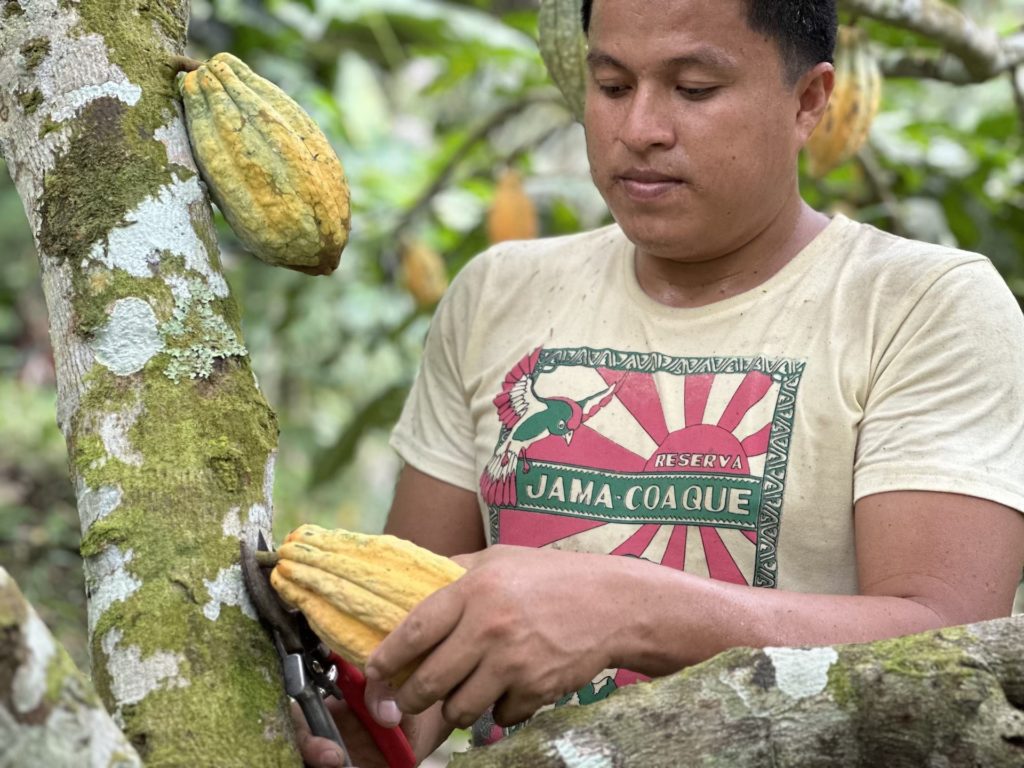
Genetics of Capuchin Cacao
Capuchin Cacao is sourced entirely from cacao cultivars within the Nacional genetic family, including 100% pure Ancient Nacional—once believed to be extinct. The breeding ground for Capuchin Cacao are the experimental cacao plots in the Jama-Coaque Reserve. For a deep-dive into the genetics of Capuchin Cacao, check out Cacao Varieties of the Jama-Coaque Reserve. Below is a brief summary:
- 10-20% of the cacao trees planted in this program are 100% pure Ancient Nacional trees cloned from old-growth trees in Piedra de Plata, verified by DNA-testing. As of 2015, there were only 15 cacao trees in all of Ecuador that were DNA-verified to be Ancient Nacional. Nine of these trees were in Piedra de Plata, all of which were already over one hundred years old and at the end of their expected lifespan. In the years that followed, To’ak and TMA embarked on a project to pull this ancient cacao variety back from the brink of extinction. I first wrote about this project in 2018 in the (rather long-winded) article called The Noah’s Ark of Ancient Nacional Cacao. I provided in an update in 2020 in a more succinct article called Heirloom Cacao Conservation Timeline.
- 40% are Heirloom Nacional cacao trees that have been growing in this region for half of a century.
- 40-50% are Nacional Hybrids developed by INIAP during the latter half of the 20th century, with the objective to maintain the flavor characteristics of Nacional cacao while increasing the productivity of the trees. The specific cultivars are EET-19, EET-62, EET-95, EET-96, EET-103, EET-575, EET-576, EET-800, EET-801.
Important Note: the bulk cacao cultivar known as CCN-51 is categorically excluded from this entire program.
Origin / Appellation
The Capuchin Corridor is a 40,000-hectare conservation corridor along a coastal mountain range that runs parallel to the Pacific Ocean at 0° latitude—literally straddling the equator line. It is bounded to the south by the town of Jama and bounded to the north by the town of Pedernales. Within its boundaries are 38 small rural communities nestled in the foothills.
The Capuchin Corridor is distinguished by an extraordinary degree of ecological diversity in a relatively small area of land. The peaks of the mountains—quickly rising 840 meters (2,700 feet) above the ocean—are the domain of cloud forests, shrouded in fog most of the year. Moist evergreen forest occupies the mid-elevational band of the mountains, giving way to tropical dry forest along the shores of the Pacific ocean. This region represents the core of the Tumbes-Chocó global biodiversity hotspot.
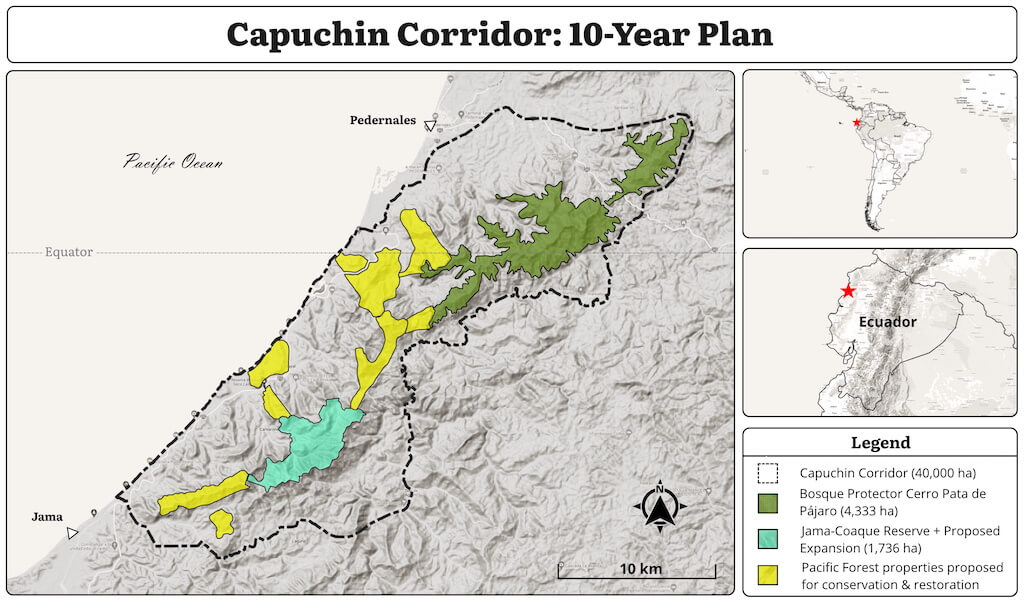 Roughly half of the Capuchin Corridor’s original forest has been replaced by a mixture of cattle pasture, corn fields, and other forms of agriculture.
Roughly half of the Capuchin Corridor’s original forest has been replaced by a mixture of cattle pasture, corn fields, and other forms of agriculture.
Annual precipitation ranges from nearly 2,000 mm along the mountaintops to less than 500 mm along the shoreline, with a pronounced dry season from June through December. The soil is predominantly clay with slightly acidic pH, naturally rich with calcium, magnesium, manganese, and potassium.
Within ten years time, the Capuchin Corridor will be to the world of chocolate what the French province of Burgundy is to the world of wine: unparalleled.
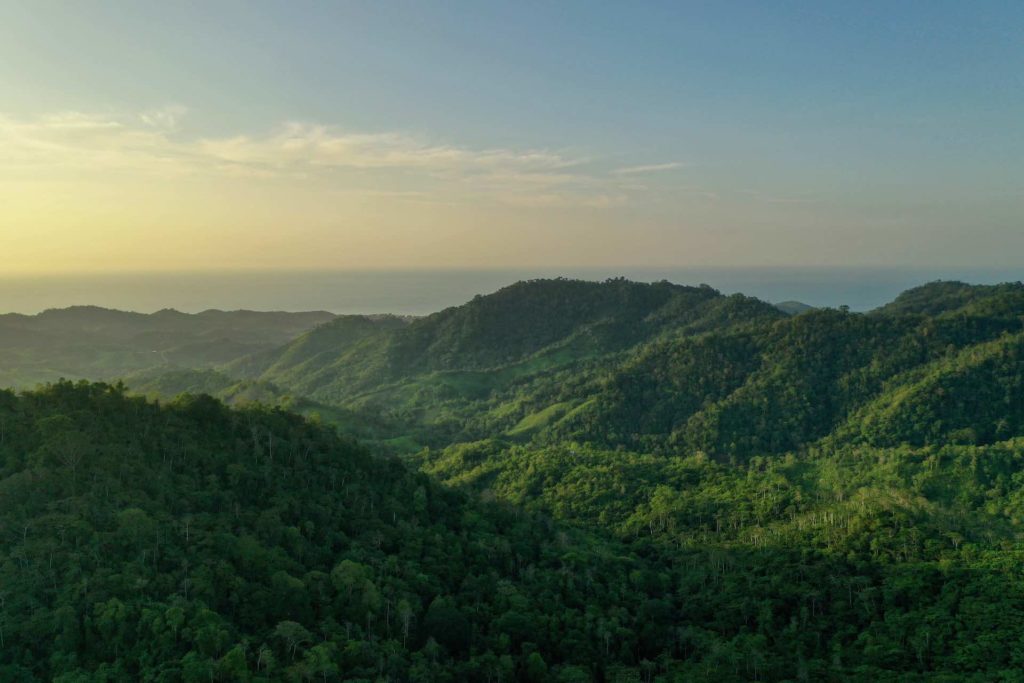
The Capuchin Corridor in coastal Ecuador—one of the last surviving remnants of the Pacific Forest of Ecuador. Photo by Ryan Lynch.
Post-Harvest
TMA is building a post-harvest facility in the community of Camarones, to be managed by local residents trained by To’ak and TMA.
The post-harvest facility will be built in the style of To’ak’s original post-harvest facility in Finca Perezoso. Wet cacao will be harvested on each farm, immediately transported to the post-harvest facility, and fermented in Spanish Elm fermentation boxes for 4-6 days, depending on the specific flavor objectives of each cacao buyer. The cacao will then be dried in an open-air marquesina with transparent roof and elevated drying racks.
The first phase of construction will be completed by February of 2024, which will allow for the fermentation and drying of up to 2 tons of wet cacao every two weeks.
The second phase of construction will be completed by December of 2024.
The first cacao lots will be available as early as April of 2024, with more production coming online during 2025.
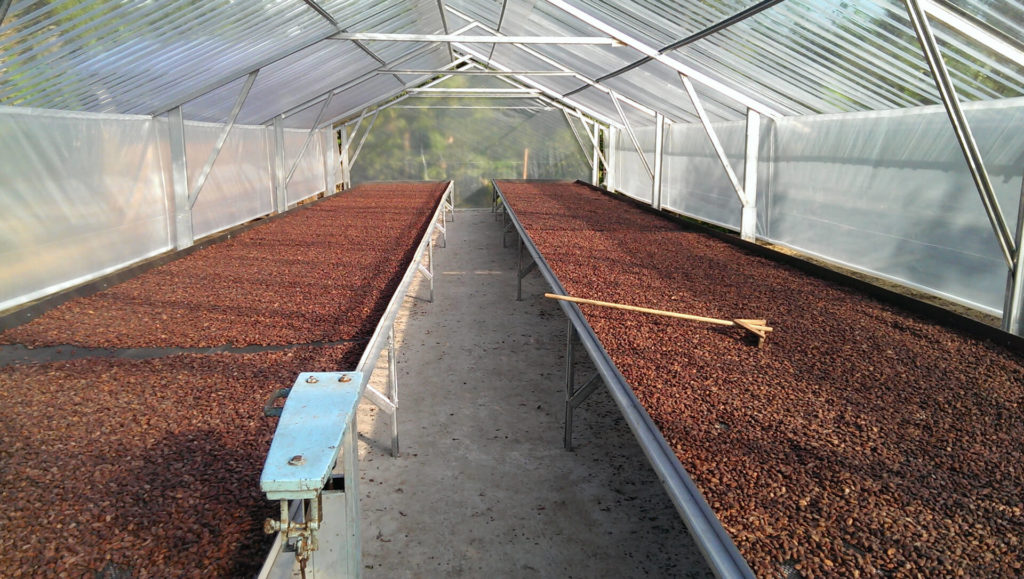
To’ak’s cacao drying facility in Sarampion. TMA is replicating this model in the Capuchin Corridor. Photo by To’ak.
Pricing
Standard market prices for cacao simply don’t provide an incentive for farmers to shift away from current practices (namely, cattle ranching and slash-and-burn corn cultivation) in favor of regenerative agroforestry. They provide even less of an incentive to cultivate high-quality Nacional cacao rather than the lower quality CCN-51, which is roughly 3x more productive than Nacional cacao.
The entire Capuchin Cacao program only works if cacao growers are paid enough money to incentivize them to make the change to regenerative agroforestry. And the only way to economically justify the cultivation of Nacional cacao rather than CCN-51 is if the price for Nacional cacao is 3x the price for CCN-51. This is the economic reality of the matter. Here’s how this looks to the farmer:
| Yield (kg/ha) | Farmer Revenue ($/ha) | ||||
| Cacao Variety | Shade Level | Wet cacao | Dry cacao | Market price | Capuchin price |
| CCN-51 | Full sun | 5600 | 2000 | $4,074 | N/A |
| Complejo Nacional (INIAP) | Full sun | 3080 | 1100 | $2,241 | N/A |
| Complejo Nacional (INIAP) | 30-40% shade | 2520 | 900 | $1,833 | $5,556 |
| Heirloom Nacional | 30-40% shade | 1400 | 500 | $1,019 | $3,086 |
| Ancient Nacional | 30-40% shade | 700 | 250 | $509 | $1,543 |
| Capuchin Cacao (1st Cru)* | 30-40% shade | 1967 | 703 | $1,431 | $4,336 |
To put it bluntly: if a chocolate maker insists on buying Nacional cacao instead of CCN-51, but isn’t willing to pay a farmgate price that justifies cultivating a lower-yield variety, he/she is basically asking the farmer to sacrifice family income. This break-even price (paid to the farmer) equates to about $2.20 per kg of wet cacao (equivalent to $6.17 per kg of dry cacao). This assumes a standard market price of $0.73/kg of wet cacao ($2.45/kg of dry cacao), which is the average price paid for CCN-51 cacao in Ecuador over the past 10 years.
For us to be able to pay Capuchin Corridor farmers a price of $2.20/kg of wet cacao, we need to sell this cacao for a price of $7,465 per ton of dry cacao. With this pricing model, 83% of the sales price goes directly to farmers, leaving 7% for post-harvest costs, and 10% to be reinvested back into the Regenerative Cacao program.
| Cost Detail | Per pound | Per kg | Per ton | % of total |
| Farmgate price paid directly to farmers for “wet cacao” | $1.00 | $2.20 | $2,205 | |
| Note: wet cacao weight divided by 2.8 = dry weight | ||||
| thus, the “dry weight” price TMA pays farmers is | $2.80 | $6.17 | $6,173 | 83% |
| Harvest, transport, and post-harvest costs | $0.25 | $0.55 | $551 | 7% |
| TMA reinvests 10% of total sales price back into program | $0.34 | $0.74 | $741 | 10% |
| Price that TMA sells “dry cacao” (FOB) to buyers | $3.39 | $7.46 | $7,465 |
We’re looking for craft chocolate companies that acknowledge this economic reality and embrace the opportunity to properly compensate cacao growers for the work they do. In exchange, we offer:
- Access to one of the most progressive cacao appellations in the world
- With an utterly unique genetic lineage
- A truly compelling story to share with your customers
- Biodiversity metrics and a robust monitoring system to ensure quality
- A steady stream of videos, photos, and publicity at your disposal
Interested in Becoming a Partner?
If you’re a craft chocolate maker interested in being a part of this project and sourcing your cacao from the Capuchin Corridor, please fill out this form and we will get back to you. The inaugural lots of cacao will be available as early as April of 2024, considerably ramping up in 2025.
